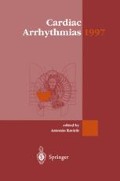Abstract
Carotid sinus syndrome is diagnosed in patients with syncope who are found to have an hyperactive carotid sinus reflex to the carotid sinus massage test and a negative work-up. Hyperactive carotid sinus reflex is present if the carotid sinus massage produces asystole exceeding 3 s (a cardioinhibitory response) or a reduction in systolic blood pressure exceeding 50 mmHg (a vasodepressor response). These limits were chosen by Franke [1] among a large population of healthy subjects and patients with various diseases. They have been accepted widely even if they represent a workable compromise since an asystolic pause of 3 seconds and a decrease of blood pressure of 50 mmHg can also be observed in subjects without syncope. The reproduction of spontaneous symptoms during the carotid sinus massage seems to add specificity to the definition of the syndrome.
Access this chapter
Tax calculation will be finalised at checkout
Purchases are for personal use only
Preview
Unable to display preview. Download preview PDF.
References
Franke H (1963) Uber das Karotissinus-Syndrome und den sogenannten hyperactiven Karotissinus-Reflex. Friedrich-Kave Schattauer Verlag, Stuttgart
Thomas JE (1969) Hyperactive carotid sinus reflex and carotid sinus syncope. Mayo Clin Proc 44: 127–139
Stasberg B, Sagie A, Erdman S, Kusniec J, Sclarovsky S, Agmon J (1989) Carotid sinus hypersensitivity and the carotid sinus syndrome. Prog Cardiovasc Dis 31: 379–391
Graux P, Mekerke W, Lemaire N, Beaugeard D, Cornaert P, Dubeaux PA, Dutoit A, Croccel L (1989) Le syndrome du sinus carotidien. Apport de la monitorisation de la pression arterielle à l’exploration électrophysiologique endocavitaire. Arch Mal Coeur 82: 193–199
Brignole M, Barra M, Prato R, Sartore B, Bertulla A (1985) Cardioinhibitory and vasodepressor reflexes and orthostatic hypotension in carotid sinus syndrome. Cardiologia 30: 601–603
Brown KA, Maloney JD, Hugh CS, Hartzler GO, Ilstrup DM (1980) Carotid sinus reflex in patients undergoing coronary angiography: relationship of degree and location of coronary artery disease to response to carotid sinus massage. Circulation 62: 697–703
Almquist A, Gornick C, Benson W, Dunningan A, Benditt DG (1985) Carotid sinus hypersensitivity: evaluation of the vasodepressor component. Circulation 71: 927–936
Gaggioli G, Brignole M, Menozzi C, Bottoni N, Gianfranchi L, Oddone D, Lolli G (1995) Reappraisal of the vasodepressor reflex in carotid sinus syndrome. Am J Cardiol 75: 518–521
McIntosh S, Lawson J, Kenny RA (1993) Clinical characteristics of vasodepressor, cardioinhibitory and mixed carotid sinus syndrome in the elderly. Am J Med 95: 203–208
Morley CA, Sutton R (1984) Carotid sinus syncope. Int J Cardiol 6: 287–293
Kenny RA, Lyon CC, Ingram AM, Bayliss J, Lightman SL, Sutton R (1987) Enhanced vagal activity and normal arginine vasopressin response in carotid sinus syndrome: implications for a central abnormality in carotid sinus hypersensitivity. Cardiovasc Res 21: 545–550
Luck JC, Hoover R, Sutliff G, Leuenberger U, Ettinger S, Sinoway L (1994) Measurement of sympathetic nerve activity in carotid sinus hypersensitivity. Eur J Cardiac Pacing Electrophysiol 4, 2 (suppl 4 ): 25 (abstr)
Brignole M, Barra M, Sartore B, Bertulla A (1985) The association of carotid sinus syndrome and orthostatic hypotension. Another possible cause of failure of VVI pacing. G Ital Cardiol 15: 971–973
Brignole M, Sartore B, Barra M, Menozzi C, Lolli G (1989) Ventricular and dual-chamber pacing for treatment of carotid sinus syndrome. PACE 12: 582–590
Brignole M, Sartore B, Barra M, Menozzi C, Lolli G (1988) Is DDD superior to VVI pacing in mixed carotid sinus syndrome? An acute and medium-term study. PACE 11: 1902–1910
Brignole M, Sartore B, Prato R, Barra M, Menozzi C, Monducci I (1983) Carotid sinus syndrome: recognition of cardioinhibitory and vasodepressor type. Indications for treatment. Cardiostimolazione 1: 125–131
Walter PF, Crawley IS, Dorney ER (1978) Carotid sinus hypersensitivity and syncope. Am J Cardiol 42: 396–403
Brignole M, Menozzi C, Lolli G, Oddone D, Gianfranchi L (1991) Validation of a new method for the choice of the pacing mode in carotid sinus syndrome with or without sinus bradycardia. PACE 14: 196–203
Brignole M, Oddone D, Cogorno S, Menozzi C, Gianfranchi L, Bertulla A (1992) Survival in symptomatic carotid sinus hypersensitivity. Am Heart J 123: 687–692
Brignole M, Menozzi C, Lolli G, Bottoni N, Gaggioli G (1992) Long-term outcome of paced and non-paced patients with severe carotid sinus syndrome. Am J Cardiol 69: 1039–1043
Gaggioli G, Brignole M, Menozzi C, Devoto G, Gianfranchi L, Gostoli E, Bottoni N, Lolli G (1995) A positive response to head-up tilt test predicts syncopal recurrence in carotid sinus syndrome patients treated with permanent pacemaker. Am J Cardiol 76: 720–722
Menozzi C, Brignole M, Lolli G, Bottoni N, Oddone D, Gianfranchi L, Gaggioli G (1993) Follow-up of asystolic episodes in patients with cardioinhibitory, neurally-mediated syncope and VVI pacemaker. Am J Cardiol 72: 1152–1155
Brignole M, Menozzi C, Gaggioli G, Musso G, Foglia-Manzillo G, Mascioli G, Fradella G, Bottoni N, Mureddu R (1997) Effects of chronic vasodilator therapy in patients with carotid sinus hypersensitivity (in press)
Author information
Authors and Affiliations
Editor information
Editors and Affiliations
Rights and permissions
Copyright information
© 1998 Springer-Verlag Italia
About this chapter
Cite this chapter
Menozzi, C., Brignole, M. (1998). Carotid Sinus Syndrome: What Is the Clinical Relevance of the Vasodepressor Component and How to Manage It?. In: Raviele, A. (eds) Cardiac Arrhythmias 1997. Springer, Milano. https://doi.org/10.1007/978-88-470-2288-1_48
Download citation
DOI: https://doi.org/10.1007/978-88-470-2288-1_48
Publisher Name: Springer, Milano
Print ISBN: 978-88-470-2290-4
Online ISBN: 978-88-470-2288-1
eBook Packages: Springer Book Archive

